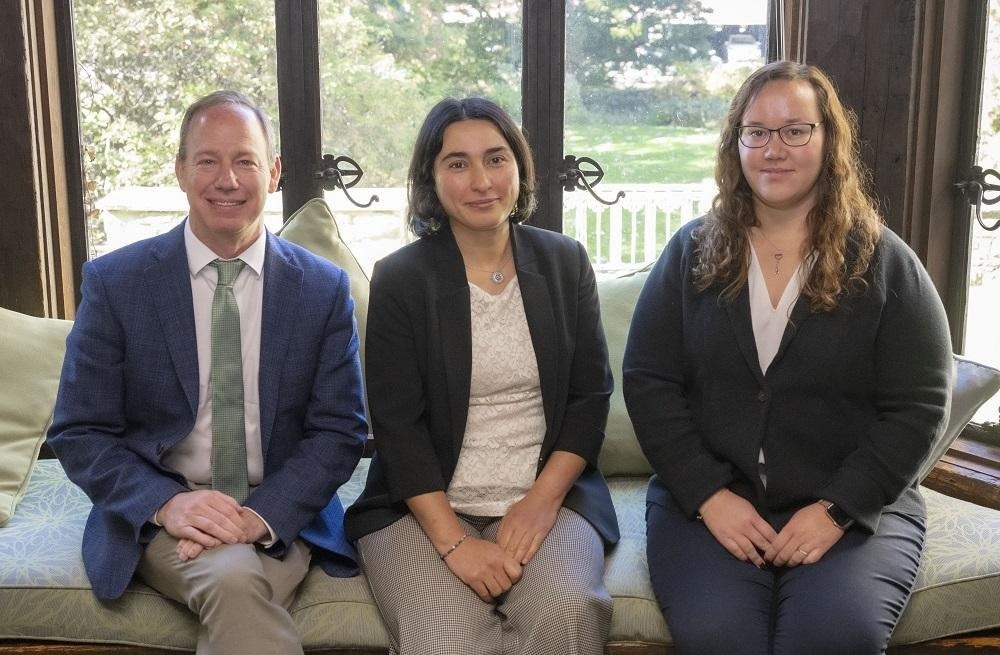
From left, Dr. Lawrence Rhein, Ulkuhan Guler, and Bige Unluturk. Image Credit: Worcester Polytechnic Institute
The funding aims to support the development of a groundbreaking wearable sensor for premature infants. This sensor will tackle racial bias in healthcare by monitoring oxygen levels through two distinct methods and adjusting the measurements to accommodate variations in skin color.
Over four years, the project aims to produce a compact, cost-effective, noninvasive sensor roughly the size of a bandage. This sensor will facilitate the early discharge of infants susceptible to lung disease from hospitals, allowing accurate monitoring in a home setting. Ulkuhan Guler, an Associate Professor in the Department of Electrical and Computer Engineering, serves as the principal investigator for the project.
Premature infants are at risk of respiratory distress, and oxygen monitoring is critical to their care so that they can leave hospitals and go home. Some tools widely used at home to monitor oxygenation, however, do not accurately measure oxygen levels in infants with pigmented skin tones. There is a great need for new technology that mitigates the impact of racial bias in measurements and provides important information to the clinicians who are treating these infants.
Ulkuhan Guler, Associate Professor, Department of Electrical and Computer Engineering, Worcester Polytechnic Institute
In the research endeavor, Guler will collaborate with co-investigators Dr. Lawrence Rhein, Associate Professor and Chair of the Department of Pediatrics at UMass Chan Medical School, and Bige Unluturk, Assistant Professor of Electrical Engineering and Biomedical engineering at Michigan State University.
The team will work on creating a wireless patch equipped with a miniaturized, low-power electronic sensor. This sensor will utilize light to measure blood oxygen levels through two distinct methods: a transcutaneous blood gas monitor, which detects oxygen gases diffusing through the skin, and a pulse oximeter, which assesses reflected or refracted light to determine oxygen saturation in hemoglobin, a protein present in red blood cells.
The sensor will send data to a compact communications hub that can be positioned on an infant's crib or carrier. This hub will run a bias-mitigation algorithm designed to correct inaccuracies in measurements for individuals with different skin colors. The researchers will integrate both hardware and software into a system that will undergo pilot testing on adults and infants in a clinical setting.
The project tackles a multifaceted health and equity challenge. To evaluate a respiratory patient's capacity to intake oxygen and distribute it to the body's tissues, doctors typically resort to drawing blood from an artery. However, this approach is invasive, painful, and only yields data for a specific moment in time.
Pulse oximeters, including those that attach to a fingertip, employ indirect methods to estimate arterial oxygen levels. However, research has indicated that this technology tends to underestimate oxygenation in individuals with pigmented skin.
A retrospective study involving 7,126 patients during the COVID-19 pandemic revealed that pulse oximetry overestimated oxygen saturation in Asian, Black, and Hispanic patients compared to White patients. This overestimation failed to identify Black and Hispanic patients who met the criteria for treatment.
In a distinct study involving 294 premature infants, it was observed that pulse oximetry consistently underestimated oxygen levels and hypoxemia (abnormally low oxygen levels) in Black infants when compared to White infants. Furthermore, Guler noted that pulse oximetry is unable to detect excessive oxygenation, or oxygen poisoning, in infants undergoing oxygen therapy.
The current project by the researchers is an extension of Guler's prior efforts to create more precise oxygen sensors. In recognition of her work on the development of a noninvasive sensor for infants that indirectly measures oxygen and carbon dioxide levels in arterial blood, she was awarded the prestigious CAREER Award from the National Science Foundation in 2022. Guler's work in this domain has led to several patent applications.
The team, including Guler, Rhein, and Unluturk, recently presented their research at a WPI symposium they organized titled New Directions in Transcutaneous Blood Gas Monitoring.
While the primary focus of the new research is on infants with respiratory issues, the sensor technology holds the potential for broader applications. It could also be employed to monitor adults with respiratory conditions such as asthma and chronic obstructive pulmonary disease (COPD).
Improved sensors have the potential to help many patients, not just premature infants. If doctors could accurately, effectively, and continuously monitor patients at home, they could potentially discharge premature babies and adults from hospitals earlier and reunite families, which could improve health outcomes and prevent health disparities that can have lifelong consequences.
Ulkuhan Guler, Associate Professor, Department of Electrical and Computer Engineering